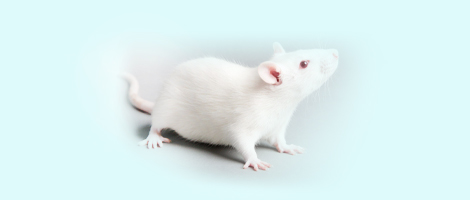













实验动物与比较医学 ›› 2014, Vol. 34 ›› Issue (5): 365-371.DOI: 10.3969/j.issn.1674-5817.2014.05.004
所属专题: 实验动物资源开发与利用
刘月环1,2, 王志远1, 杜江涛1, 吴旧生2, 余陈欢1, 陈文文1, 应华忠1
收稿日期:2014-03-12
出版日期:2014-10-25
发布日期:2014-10-25
作者简介:刘月环(1974-), 女, 副研究员, 博士, 研究方向:生物技术与实验动物育种, E-mail:yuehuanliu@163.com
基金资助:LIU Yue-huan1, WANG Zhi-yuan1, DU Jiang-tao1, WU Jiu-sheng2, YU Chen-huan1, CHEN Wen-wen1, YING Hua-zhong1
Received:2014-03-12
Published:2014-10-25
Online:2014-10-25
摘要: 目的 初步建立长爪沙鼠自发型高脂血症模型的血清脂蛋白琼脂糖电泳检测方法和肠菌PCR-DGGE检测方法,用于今后评价沙鼠高脂血症模型。方法 选取444只长爪沙鼠,按性别年龄分组后CO2麻醉,取血液及肝脏标本,用于血清转氨酶、总胆固醇(TC)、甘油三脂(TG)、高密度脂蛋白(HDL-C)、低密度脂蛋白(LDL-C)等指标的检测以及肝脏病理学的观察,血清脂蛋白电泳(琼脂糖电泳)进行高脂分类; 取小肠、盲肠内容物用PCR-DGGE技术进行肠道微生物多样性检查,同时参照人类的高脂血症分类标准,对高龄组(平均12.81月龄)个体进行了高脂血症的分型。结果 约有10%~30%高龄组沙鼠其血清丙氨酸氨基转移酶(ALT)、门冬氨酸氨基转移酶(AST)、TG、TC、血糖(GLU)等指标明显高于低龄组(平均4.72月龄)沙鼠。病理学检查发现,高龄组肝脏出现较为明显的脂肪变性,而低龄组鼠肝脏无异常发现。DGGE结果表明,高龄组与低龄组沙鼠呈现出不同的带谱,后者条带数明显多于前者。高龄鼠从血脂指标上可分为五种类型,以对应于人的Ⅱa、Ⅱb、Ⅲ、Ⅳ、Ⅴ。结论 高沙鼠的自发性高脂血症或可以作为一个潜在的模型研究,琼脂糖电泳法和PCR-DGGE法或可作为评价高脂血症沙鼠模型的补充方法。
中图分类号:
刘月环,王志远,杜江涛,等. 长爪沙鼠高脂血症的初步研究[J]. 实验动物与比较医学, 2014, 34(5): 365-371. DOI: 10.3969/j.issn.1674-5817.2014.05.004.
LIU Yue-huan,WANG Zhi-yuan,DU Jiang-tao,et al. Preliminary Detection of Hyperlipidemia in Mongolian Gerbils[J]. Laboratory Animal and Comparative Medicine, 2014, 34(5): 365-371. DOI: 10.3969/j.issn.1674-5817.2014.05.004.
| [1] Kris-Etherton PM and Diteschy J.Design criteria for studies examing individual fatty acid effects cardiovascular disease risk factors: human and animal studies[J]. Am J Clin Nutr, 1997, 65(5suppl):1590S-1596S. [2] Fernandez ML,Wilson TA, Conde K, et al.Hamsters and guinea Pigs differ in their Plasma lipoprotein cholesterol distribution when fed diets varying in animal Protein, soluble fiber or cholesterol content[J].J Nutr, 1999, 129(7):1323-1332. [3] Hegsted DM, Gailagher A.Dietary fat and cholesterol and serum cholesterol in the gerbil[J]. J Lipid Res, 1967, 8(3):210-214. [4] 钟民涛, 王迎, 卢静, 等. 长爪沙鼠的高脂血症与动脉粥样硬化相关性分析[J]. 中国比较医学杂志, 2006, 16(6):321-324. [5] Johansson MBN, Karlsson BW.Lipoproteins in serum of rat, mouse, gerbil, rabbit, pig and man studied by electrophoretical and immunological methods[J]. Comp Biochem Physiol B, 1976, 54(4):495-500. [6] Karlsson BW,Larsson GB.Lactic and malic dehydrogenases and their multiple molecular forms in the Mongolian gerbil as compared with the rat, mouse and rabbit[J]. Comp Biochem Physiol B, 1971, 40(1):93-108. [7] Wigg AJ, Robes Thomson IC, Dymock RB, et a1. The role of small intestinal bacterial overgrowth, intestinal permeability, autotoxemia and tumor necrosis factor Alpha in the pathogenesis of nonalcoholic steatohepatitis[J]. Gut, 2001, 48(2):206-21l. [8] Chitturi S, Farrell GC.Etiopathogenesis of nonalcoholic steatohepatitis[J]. Semin Liver Dis, 2001, 21(1):27-41. [9] Backhed F, Manchester JK, Semenkovich CF, et a1. Mechanisms underlying the resistance to diet-induced obesity in germ-free mice[J]. Proc Natl Acas Sci, 2007, 104(3):979-984. [10] 张磊艺, 丁淑兰等. 双歧杆菌复合制剂对脂质代谢的影响[J]. 中国微生态学杂志, 1997, 3(9):351. [11] 罗海峰, 齐鸿雁, 薛凯, 等. 在PCR-DGGE 研究土壤微生物多样性中应用GC发卡结构的效应[J]. 生态学报, 2003, 23(10):2170-2175. [12] 刘霞, 刘社兰, 解奕瑞, 阮冰. 基于16S rRNA基因和细菌基因组间重复序列的DNA指纹图谱技术对肝硬化大鼠肝移植后肠道菌群多样性的研究[J]. 中国微生态学杂志,2010, 22(3):193-198. [13] McCracken VJ, Simpson JM, Mackie RI, et al. Molecular ecological analysis of dietary and antibiotic induced alterations of the mouse intestinal microbiota[J]. J Nutr, 2000, 131(6):1862-1870. [14] 林武, 吴丽萍. 高脂饲料致高脂血症大鼠模型的研究[J]. 现代实用医学, 2013, 25(2):171-172. [15] Ying HZ, Yu CH, Wang ZY, et al.Characterization and Mechanisms of lipid metabolism in high-fat diet induced hyperlipidemia gerbil model[J]. African Journal of Biotechnology, 2012, 11(97):6347-6352. [16] 李巍, 石巧娟, 郭红刚, 等. 三种啮齿类动物非酒精性脂肪肝形成及机制探讨[J]. 中国实验动物学报, 2012, 20(1):76-80. [17] 王彩云, 杨敬芳, 田亚平. SEBIA电泳仪及其配套试剂测定血清蛋白电泳的方法学评价[J]. 现代检验医学杂志, 2003, 18(2):6-7. [18] 王育芳, 王佳丽, 马顺高. 血清蛋白电泳和免疫固定电泳在多发性骨髓瘤中的应用分析[J]. 检验医学与临床, 2013,10(5):577-579. [19] Eyssen H, Caenepeel PH.Metabolism of fats, bile acids and steroids[M]. In:Rowland, IR eds. Role of the Gut Flora in Toxicity and Cancer. London:Academic Press, 1988:263-286. [20] Tringe SG, Von Mering C, Kobayashi A, et al.Comparative metagenomics of microbial communitties[J]. Science, 2005, 308(5721):554-557. [21] Osawa R, Kuroiso K, Goto S, et al.Isolation of tannin-degrading lactobacilli from humans and fermented foods[J]. Appl Environ Microbiol, 2000, 66(7):3093-3097. [22] Smith AH and Mackie RI. Effect of condensed tannins on bacterial diversity and metabolic activity in the rat gastrointestinal tract[J]. Appl Environ Microbiol , 2004, 70(2):1104-1115. [23] Hooper LV, Wong MH, Thelin A, et al.Molecular analysis of commensal hot-microbial relationships in the intestine[J]. Science, 2001, 29(2):881-884. [24] 郭秀兰. 猪肠道硬壁门和拟杆菌数量的检测及其相对丰度与脂肪沉积的相关性研究[D]. 成都: 四川农业大学博士论文. 2009. |
| [1] | 焦青贞, 吴桂华, 唐雯, 樊帆, 冯凯, 杨春响, 乔建, 邓素芳. 暖通系统暂停送风下实验动物设施氨浓度的动态监测与分析[J]. 实验动物与比较医学, 2025, 45(4): 490-495. |
| [2] | 刘文涛, 罗艳红, 龙永霞, 罗启慧, 陈正礼, 刘丽达. 四川省实验动物设施常见环境问题及检测经验[J]. 实验动物与比较医学, 2025, 45(4): 483-489. |
| [3] | 赵鑫, 王晨曦, 石文清, 娄月芬. 斑马鱼在炎症性肠病机制及药物研究中的应用进展[J]. 实验动物与比较医学, 2025, 45(4): 422-431. |
| [4] | 贡磊磊, 王晓霞, 封学伟, 李心蕾, 赵涵, 张雪艳, 冯欣. 不同浓度环磷酰胺诱导早发性卵巢功能不全小鼠模型及作用机制研究[J]. 实验动物与比较医学, 2025, 45(4): 403-410. |
| [5] | 林振华, 褚祥宇, 魏振西, 董传俊, 赵增琳, 孙晓霞, 李庆雨, 张琪. 椎体成形术用于实验猪体内骨水泥安全性及有效性评价[J]. 实验动物与比较医学, 2025, 45(4): 466-472. |
| [6] | 姜娟, 宋宁, 连文博, 邵丛丛, 顾文文, 石燕. 两种浓度乙醇溶液灌注建立小鼠宫腔粘连模型的组织病理和分子病理表型比较[J]. 实验动物与比较医学, 2025, 45(4): 393-402. |
| [7] | 刘月琴, 薛卫国, 王淑友, 申耀华, 贾术永, 王广军, 宋晓晶. 探头式激光共聚焦成像技术用于小鼠消化道组织形态特征分析[J]. 实验动物与比较医学, 2025, 45(4): 457-465. |
| [8] | 郑卿勇, 杨冬华, 马智超, 周姿余, 陆洋, 王晶宇, 邢丽娜, 康迎英, 杜莉, 赵春香, 狄宝山, 田金徽. 动物实验系统评价与Meta分析报告的规范撰写建议[J]. 实验动物与比较医学, 2025, 45(4): 496-507. |
| [9] | 王庭君, 罗浩, 陈琦. 基于人工智能的实验动物中心信息化升级及应用实践[J]. 实验动物与比较医学, 2025, 45(4): 473-482. |
| [10] | 王娇祥, 张璐, 陈姝含, 角德灵, 赵恒, 魏太云, 郭建雄, 徐凯祥, 魏红江. GTKO/hCD55基因编辑异种器官移植供体猪的构建及功能验证[J]. 实验动物与比较医学, 2025, 45(4): 379-392. |
| [11] | 秦超, 李双星, 赵婷婷, 蒋晨晨, 赵晶, 杨艳伟, 林志, 王三龙, 文海若. 药物安全评价用SD大鼠90 d喂养试验的背景数据研究[J]. 实验动物与比较医学, 2025, 45(4): 439-448. |
| [12] | 刘鹍, 兰青, 易兵, 谢晓婕. 药物非临床生殖毒性试验中动物妊娠的主要难点及应对方法[J]. 实验动物与比较医学, 2025, 45(4): 449-456. |
| [13] | 孙强. 非动物实验替代知多少[J]. 实验动物与比较医学, 2025, 45(4): 508-514. |
| [14] | 陈子宜, 孙红燕, 康品方, 武文娟. 肺动脉高压动物实验模型的研究进展[J]. 实验动物与比较医学, 2025, (): 1-12. |
| [15] | 徐英韬, 王蒙蒙, 林平, 迟海涛, 王怡, 白鹰. 外泌体通过NRF2/SLC7A11/GPX4通路调控铁死亡治疗小鼠缺血性脑卒中[J]. 实验动物与比较医学, 2025, (): 1-11. |
| 阅读次数 | ||||||
|
全文 |
|
|||||
|
摘要 |
|
|||||